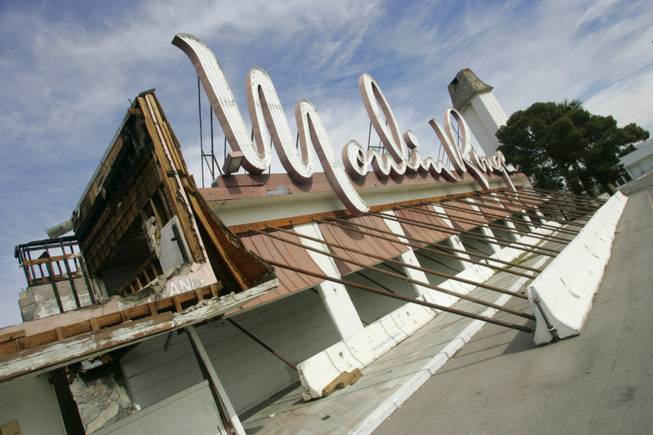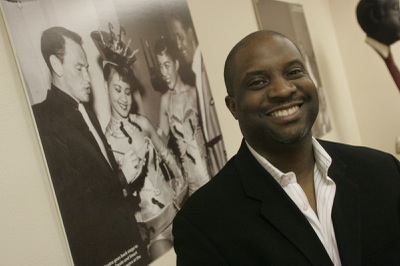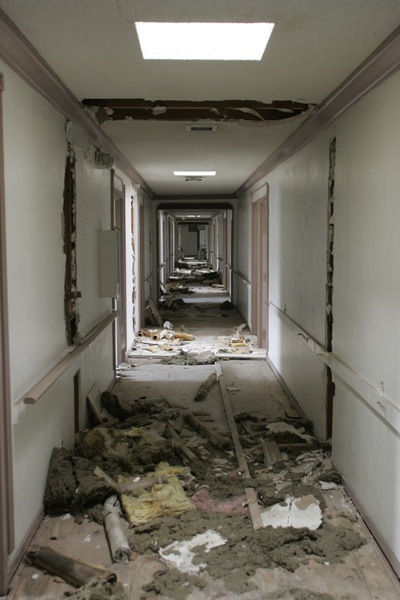
Little is left of the Moulin Rouge, which operated as an integrated resort in 1955. At least three recent revival plans have failed.
Monday, Feb. 25, 2008 | 2 a.m.
Beyond the Sun
For at least the third time in the past four years, the Moulin Rouge has announced it will rise again, this time propped up by a Virginia-based company’s investment.
The Bonanza Road hotel’s owners will present their casino and hotel construction plans to the community this afternoon in a public meeting at their offices east of the hotel.
The stakes are high because the Moulin Rouge is one of only about 20 local listings on the National Register of Historic Places — and the only one connected to civil rights.
Though open for less than 12 months in 1955, the Moulin Rouge was a hotel and casino where blacks and whites partied together. It became a symbol of integration. In 1960 casino owners, the NAACP and others met at the site and agreed to end segregation on the Strip.
Then the hotel set foot on what Ron James, state historical preservation officer, called the “meandering path that is often unbecoming” for such places. Cheap apartments opened. In 2003 a fire caused an estimated $12 million in damage. On a winter morning a few years later, a man died in his room of hypothermia. He had no heat.
The city and county eventually fined the owners $199,000 for running a slum. They paid $129,120, thanks to $70,000 in civil penalties being waived.
Starting in 2004, owners of the property began announcing that the Moulin Rouge would return to glory, and add a museum. At least two attempts failed. This month Republic Urban Properties, based just outside Washington, D.C., said it will invest up to $1 billion in a 700-room hotel, with restaurants, a concert hall, stores and gambling.
The announcement was carried in reports around the country, but those familiar with the site are skeptical about the plan. The property is in a run-down neighborhood, near one of the valley’s largest homeless shelters.
There’s also the track record of Chauncey Moore, chief operating officer of Moulin Rouge Development Corp., the local company that owns the property. Moore is currently a defendant in lawsuits filed in three states.
In Las Vegas a security company alleges Moore and two of his Moulin Rouge Development partners broke a contract and owe at least $10,000. Then there’s the claim for unpaid child support that Moore’s former wife, Sonja Mack, has against him. A Las Vegas judge has ruled he owes at least $29,000 but the case is still winding through San Diego courts.
Finally, a company in South Carolina says Moore has broken a real estate deal and owes as much as $3.5 million. A judge there is expected to rule on that soon.
Between what has happened with previous Moulin Rouge plans and the allegations against Moore, some question not only the viability of future plans but the true intentions of those close to the project.
“The local black community has been held psychic hostage by the owners (of the Moulin Rouge),” said Rainier Spencer, director of the UNLV Afro-American Studies program. Spencer says owning the Moulin Rouge is “really a privilege,” given the site’s historical importance for blacks in Las Vegas and nationwide. He thinks the track record of Moore and company is so bad that it can’t be cured, not even by dump trucks full of money.
Moore did not return calls from the Sun. Neither did Republic Urban Properties.
But Alan Glover, hired to do marketing for the project, was sunny about Moulin Rouge’s future on a recent afternoon.
Ironically, his office sits in a building east of the hotel that once housed the transportation department for the Economic Opportunity Board. The EOB, founded in the War on Poverty, was once the valley’s largest nonprofit organization, until federal and state investigations into mismanagement brought it down in 2006. Its demise is seen as one of a string of disappointments in the black community.
Outside the one-story brick office, two tenants of the dozen or so apartments left on the Moulin Rouge property are complaining about their pending eviction in March.
Glover hopes demolition of the site will begin this summer.
The walls of his office are lined with white boards that map out a plan for a public relations blitz stretching to London, Madrid and Zurich. Moore is in a nearby conference room with architect Edward A. Vance and money men. A plaque in the hallway says, “Only those who see the invisible can do the impossible.”
Glover notes his street credentials include being born in Harlem to a mother who teaches black history.
When he first ran across the Moulin Rouge, he says, it “evoked the understanding of history that I have had as a child.”
He says Bonanza Road is like 125th Street in Harlem, which in the space of decades went from being “ravaged” by heroin and crime to being a place where cafes open their doors each morning.
He says the current Moulin Rouge plans are about “keeping history alive,” that the project will go beyond the previous ideas of opening a museum or community center.
“It’s not just a museum, but an entertainment center,” he says. “We’ll do it bigger and better.”
He lays out an idea of “branding” black history, turning the struggle of millions into a theme for the Moulin Rouge, similar to the way other casinos have done themes on Paris or Venice.
This makes Spencer steam.
“The importance of the buildings there is what they were. Turning it into a new casino diminishes its significance,” he says, adding that he thinks the site should be turned into a museum.
“The memory of what it was is what’s important, not taking it and turning it into a black-themed casino.”
“That,” he says, “is a bizarre kind of historical pornography.”
Spencer says the new plans will strip the site of its meaning.
“If people take a broader look, it doesn’t mean anything to the black community. It’s just another business.”
Charles J. Fisher, an expert on historical sites in Los Angeles, says that a best-case scenario for such sites is a developer with vision and capital. The Moulin Rouge case appears to be lacking vision, Fisher says. It “sounds like they’re using history as a way to make money,” he says.
But James, the Nevada official, says preservationists must be practical, especially in Nevada, where many buildings don’t survive long.
“If they preserve anything, it’s a step forward,” James says.
He says the owners could build an Irish pub on the site and it would still be better than doing nothing.
James also recalled how he went to federal officials after the 2003 fire and asked if the Moulin Rouge should still be on the Register of Historic Places, given the destruction. Officials at the National Park Service, the agency charged with keeping the list, said yes.
“They told me, ‘Enough survived, let’s hope for a better day.’ ”



Join the Discussion:
Check this out for a full explanation of our conversion to the LiveFyre commenting system and instructions on how to sign up for an account.
Full comments policy